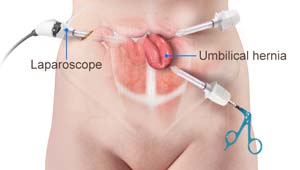Umbilical and Paraumbilical Hernia Repair

What are Umbilical and Paraumbilical Hernias?
An umbilical or paraumbilical hernia is a weakness in the abdominal wall at or near the navel through which the contents of the abdomen protrude to form a bulge. This area of weakness is in the region where the umbilical cord used to pass. The bulge is caused by the protrusion of intestines or fatty tissue.
What Causes Umbilical and Paraumbilical Hernias?
The umbilical cord passes through a space between the abdominal muscles that usually closes soon after birth. This closure may not always happen adequately resulting in a weak spot where a hernia may develop.
Umbilical or paraumbilical hernias are more common in infants, especially premature babies. However, adults can also develop the condition, especially women and obese individuals. Other risk factors include previous abdominal surgery, multiple pregnancies, excess fluid in the abdomen and a persistent cough.
Impact of Umbilical and Paraumbilical Hernia
Umbilical or paraumbilical hernias may cause discomfort and sometimes pain preventing you from functioning normally. The contents of umbilical or paraumbilical hernias can usually be reduced or pushed back into the abdominal cavity. However, they may become trapped or incarcerated with loss of blood supply or obstruction of the bowel. This can be life-threatening and needs emergency care.
Symptoms of Umbilical and Paraumbilical Hernia
Umbilical or paraumbilical hernias present as a lump or soft bulge at or near the navel. In children, the condition is not usually painful. The bulge becomes more pronounced when a child cries, strains with bowel movements or coughs. It reduces in size when the child is relaxed or lying down. The hernia usually resolves by itself at 12 months of age as the abdominal wall is strengthened, but surgery is recommended if the hernia persists beyond the age of 4. Adults are more likely to experience pain with un umbilical or paraumbilical hernia. An incarcerated or unreducible hernia may be associated with discoloration, severe pain, tenderness, nausea and vomiting and is considered an emergency requiring treatment.
Diagnosis of Umbilical and Paraumbilical Hernia
Your doctor will review your or your child’s symptoms and perform a physical examination to identify the hernia, its contents and whether they can be reduced back into the abdominal cavity. An x-ray or ultrasound may be ordered to look for complications. Blood tests may be ordered to see if there is an infection or ischemia (reduced blood supply to an organ or region) in case the hernia is nonreducible.
Untreated Umbilical and Paraumbilical Hernia
Untreated umbilical or paraumbilical hernias in children may resolve on their own by the age of 1. Surgery is recommended if it persists or becomes complicated. Adults usually require surgical repair as the hernia will probably worsen by getting larger and more painful or becoming complicated.
Treatment for Umbilical and paraumbilical Hernia
Umbilical or paraumbilical hernias that do not resolve on their own usually need surgical treatment. In children, the abdominal wall may be reinforced with stitches. Hernias in adults as well as large hernias in children are usually treated by placing surgical mesh.
Surgery for Umbilical and Paraumbilical Repair
The surgery takes about 20-30 minutes and is performed under general anaesthesia. Your surgeon will make a small incision below the navel to access the hernia contents and push them back into the abdominal cavity. The sac formed by the hernia is removed. Surgical mesh is placed under the defect to strengthen the area. The edges of the mesh usually extend about 3-4 cm beyond the edge of the defect to ensure that a hernia does not develop again and is sutured in place.
The skin at the incision is closed with stitches or glue. A pressure dressing may be placed over the area for 4-5 days. Surgery may also be performed by a laparoscopic method where a few tiny incisions are made and a slender illuminated scope containing a tiny camera is inserted through one of the incisions that displays magnified images on a screen for the surgeon to view. Special miniaturized instruments are used to carry out the procedure.
Preparation for Umbilical and Paraumbilical Repair
Before surgery, you or your child will receive a complete medical evaluation. Your doctor will discuss your surgery in detail. You should notify your doctor of any allergies or any medications you are taking. You may be asked to stop taking certain medications prior to surgery. The anaesthetist will also perform an evaluation. Six hours before surgery you may have to abstain from food and water.
Recovery After Umbilical and Paraumbilical Repair
Following surgery, you will be taken to a recovery room where your vital signs are closely monitored. You may be allowed to leave on the same day or following an overnight stay. Once the anaesthesia wears off, you will experience some pain for which your doctor will prescribe medications. You will receive instructions on how to care for the surgical site. Sponge baths are recommended on the initial 3 days following surgery. Avoid smoking as it can delay healing. You can usually return to your normal routine a few weeks after surgery.
Outcome of Umbilical and Paraumbilical Repair
The goals of surgery are to reduce the hernia, relieve discomfort, address complications if any and reinforce or strengthen the abdominal wall with the help of the mesh. Rarely a hernia may recur following surgery. Other complications that can occur following surgery include infection, fever, headache, nausea and vomiting and damage to surrounding organs or tissues.
Down-time, lifestyle or off-work duration for Umbilical and Paraumbilical Repair
Complete recovery following surgery can take 3 weeks.
Prognosis of Umbilical and Paraumbilical Hernia
Umbilical and paraumbilical hernias in babies usually resolve on their own by the age of 3 or 4. Surgical intervention is necessary for complicated hernias and for hernias affecting adults. Recurrence is rare following well treated hernias and is more likely in large and complicated hernias.
